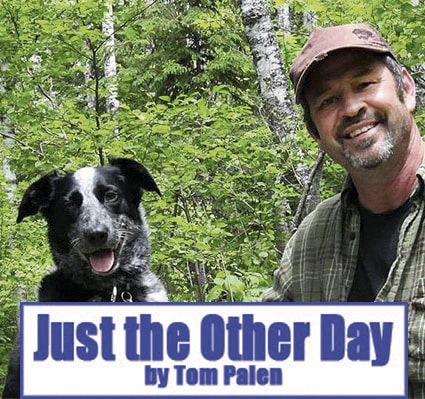Tom Palen,a broadcaster, pilot, writer, and our Guest Columnist! Archives
July 2024
Categories |
Back to Blog
Midwestern Thunderstorms4/9/2019 Not all parts of the country get them and not everyone likes them, but I do. They scare the daylights out of some people and pets, while others look forward to them, anticipating their arrival. They’re loud, powerful and can be very destructive and yet there’s still a gracefulness; a mystique and romantic charm about them that draws in many. I am talking about a meteorological-phenomena called the Midwestern thunderstorm – thunderstorms cooler than any place else in the world. I really miss them. Folks, such as myself, like to pull up a chair and watch the storm as if it was the single performance of a show coming to town for one day only.
The best seat for spectating is under a covered porch, an awning, or, maybe out in the garage or a barn with a large door, opened. Your vantage point needs a view to the west – the direction from which the storms arrive. Occasionally storms move in from the east, but that’s pretty uncommon. People are often caught off-guard. Their first sign of a storm approaching is thunder. Unsuspecting souls will hear it before ever seeing the storm. It starts with a dull noise coming from the far distance, invoking the obvious question: “Was that thunder?” A look to the west might reveal a dark sky, or massive, brilliant white cumulus clouds, still billowing and towering upward toward the heavens. Sometimes, the sky might have a brackish green color. Or, a very dark grey, nearly black line will define a squall line. When either of these appear, you know you’re in for a real doozy of a storm. I always enjoy hearing loud crashes of thunder, even stronger than fireworks. I will listen as it booms and echoes, rolling off into the distance, dissipating to silence - until the next clap sounds off. Flashes of lightning put on spectacular displays in the sky. Sometimes, the lightning jumps horizontally from cloud to cloud. Other times it shoots down vertically, striking out at the earth. I love to watch lightning by day or night. It’s power always leaves me in awe. If I’m really lucky, I might catch a bolt hitting an object on the ground, discharging its energy. Lightning strikes, though fascinating, are both dangerous and damaging. As much as I enjoy watching the lightning, I always cringed whenever it was close to our radio station towers. A 400-foot-tall steel tower is the easiest target in the area for lightning to hit. Our equipment had the best lightning protection and grounding systems available, but lightning has a mind and a will of its own; it will find a way to get in. In my 35 years as a radio broadcaster, I saw some severe lightning damage and the cost was always measured in the thousands of dollars. The visual damage inside a transmitter building was never as impressive as the outdoor damage. Lightning is very capable of splitting a massive oak tree in half, setting structures on fire and is often fatal if it strikes a person. All of the damage is done in a split second and if you blink, you might miss it all. Lightning has to be respected, as do all elements of a severe storm. Hail is kind of cool when it’s pea-sized, or even the size of nickels and dimes. It can cover the ground, giving the illusion of a snowfall in the spring or summer. But when hail is the size of golf balls, it starts denting car hoods and tops. When it gets as large as baseballs and softballs, it’s not fun anymore. It smashes through windshields, breaks house windows and destroys siding and roofs. It becomes very destructive and dangerous! The wind is a sure sign that a pending storm is about to break loose. It always kicks up just before the rains that are often torrential. When driven by the wind, rain can be pushed horizontally, in defiance of the laws of gravity. While lightning damage is isolated to the object it strikes, strong wind will tear up anything in its path. Wind will knock down power lines, snap off large branches, uproot tall trees and remove rooftops without effort. The wind, too, has to be respected. Just because the winds die down, it is not an assurance the storm is over. Frequently, it is just regrouping, finding new energy and about to wallop you with round two. A person has to be prepared for storms to flare up at any time – even when they’re not forecast. It’s just a Midwest thing. A common question asked when away from home and a storm is brewing: “Are the windows closed?” Last weekend, while in Ottumwa, Iowa, I took the opportunity to visit my old friend, Mike, at O’Hara Hardware. It was after hours and we were sitting in his office, reminiscing when I heard a rumbling. “Was that thunder?” I asked. “It sounded like a truck outside to me.” He replied. Content with his answer, we resumed our conversation. A second and louder rumbling was heard. Mike said, “That was thunder.” I knew I had to get going and was getting ready to say farewell. Then came a really familiar sound that I hadn’t heard for a while. I cocked my head and listened, to make sure I was hearing what I thought I was hearing. It started softly, then rapidly got louder and louder. It was a booming noise, that can be deafening when heavy rains are pounding down on a metal roof. I jumped out of my chair, “I have to go!” I announced hurriedly. As Mike followed me to the front door, I explained. “My dog June, is in the car waiting for me.” Are your windows opened?” He asked. I replied, “Yep. The windows are down.” At the front door, I looked out across the parking lot. Since the store was closed, Mike’s truck and my car were the only two vehicles out there. The rain was pouring straight down; water was running across the pavement toward the gutters on the street, where it was already pooling faster than the storm sewers could take it in. It was an icky feeling that settled into my stomach, seeing my car, sitting in the rain with the windows all open halfway. The visibility was reduced by the heavy rain, but not so much that I could see my sunroof was open, too! Mike unlocked the door and held it open for me. I said, “Next time I come to town, I’ll try to let you know ahead of time. Maybe we can go out to dinner!” “That sound good. Let’s do that.” He was saying as I ran away, through the rain, toward my car. In stride, I unlocked the doors with my fob. Quickly jumping into the car, I was hoping to find shelter from the rain – but you don’t get out of the rain when sitting under a giant hole in the roof. I put the key in the ignition and turned it, simultaneously holding the button to close the sunroof. June was sitting in the back of the car, where she was protected from the rain. Sarcastically, she said, “Nice work boss. Next time, maybe you’ll listen to the dog and let me come inside with you, so you can lock the car…with the windows rolled up and everything.” “Hmfph. Smart aleck.” I grumbled. Adding insult to injury, June reminded me, “You’re in Iowa now, partner. You can’t trust the weather.” The seats, the steering wheel, the center console and everything under the sun (roof) was soaked. My back was cold; my shirt was already wet and the seat back finished it off. My jeans were as drenched as if I had sat in a puddle of water – which I did, as there was literally a puddle of water in the front seat. “June Bug, do you want to sit with me up front?” I asked, while patting my hand, splashing the water in the passenger’s seat. She lowered her brow, “I think not, Dad.” “Hey Dad?” June beckoned from the back of the car. “Yeah Bugs, what’s up?” I responded. Is this part of that ‘Midwestern meteorological-phenomena,’ that you love and claim to miss?” We shared a good laugh about that. “Actually June,” I answered, “this is a part of it. Yes. Getting caught in the rain.” What the heck. Getting upset over wet seats wasn’t going to make them dry, one might as well find humor in the situation. I shook the water from my right hand and put the car in first gear. I felt warmer inside – a nostalgic feeling, that, for me, is another element of a thunderstorm - a true meteorological-phenomena that can only be experienced this way, in The Midwest.
0 Comments
Read More
Leave a Reply. |

Contact Us:
Phone: 507.238.9456
e-mail: [email protected]
Photo Press | 112 E. First Street |
P.O. Box 973 | Fairmont, MN 56031
Office Hours:
Monday-Friday 8:00 a.m. - 4:00 p.m.
Phone: 507.238.9456
e-mail: [email protected]
Photo Press | 112 E. First Street |
P.O. Box 973 | Fairmont, MN 56031
Office Hours:
Monday-Friday 8:00 a.m. - 4:00 p.m.
Proudly powered by Weebly



 RSS Feed
RSS Feed